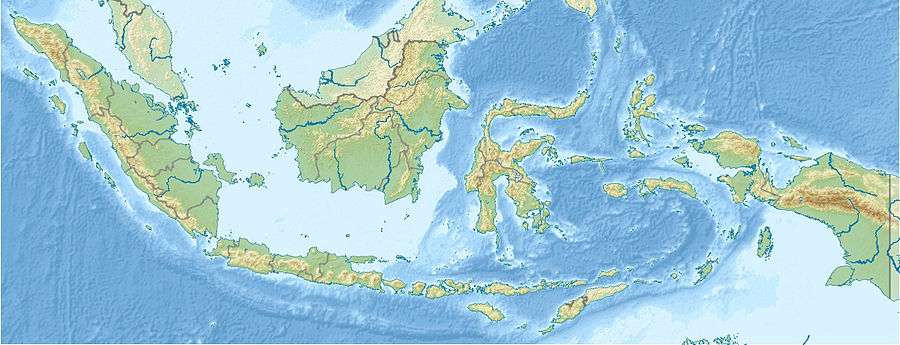Mata Menge
 Shown within Indonesia | |
| Location | Flores, Indonesia |
|---|---|
| Region | So'a Basin |
| Coordinates | 8°41′31″S 121°05′43″E / 8.69194°S 121.09528°ECoordinates: 8°41′31″S 121°05′43″E / 8.69194°S 121.09528°E |
| Type | open-air site |
| History | |
| Periods | early Middle Pleistocene |
| Site notes | |
| Excavation dates | 1991-1992,[1] 1994,[1] 2004-2006,[2] 2014[3] |
| Archaeologists | Theodor Verhoeven, Mike Morwood |
Mata Menge is an early Middle Pleistocene paleoanthropological site located in the Ola Bula Formation in the So'a Basin on the island of Flores, Indonesia. Lithic artefacts and hominin remains have been discovered at the site. The level of sophistication of the Mata Menge lithic artefacts is described as being 'simple'.[4]
Excavations
In 1970, Theodor Verhoeven and Johannes Maringer were the first to associate the remains of Stegodon florensis with stone artefacts, linking these together as evidence of early hominin colonization of Flores, a feat that requires crossing the open sea.[1]
A 1994 excavation yielded 45 lithic elements, consisting mostly of basalt and chert, with several being classified as artefacts.[1] The fossil remains of Stegodon florensis, Hooijeromys nusatenggara, crocodile and freshwater mollusk were also discovered.[1] The 1994 excavation yielded a dating of around 730,000 BP.[1]
The 2004-2006 excavation yielded the remains of 487 lithic artefacts.[4]
Hominin fossils
In October 2014, the fossil remains of an early hominin were discovered at the site.[5] A mandible and six teeth were discovered.[5] The hominin fossils belonged to at least three distinct individuals.[5] The hominin fossils were dated to around 700,000 BP,[3] making the Mata Menge fossils the oldest hominin fossils yet discovered on the island of Flores.[5] The fossils at Mata Menge are likely to belong to hominins that resulted from the effects of insular dwarfism working on Homo erectus.[5]
47 lithic artefacts were discovered in the layer containing the hominin fossils.[3] The remains of Stegodon florensis, Hooijeromys nusatenggara, Komodo Dragon and crocodile were also discovered in the layer associated with the hominin fossil remains.[3]
Comparisons to Homo floresiensis
Hominin fossils at Mata Menge, in particular the mandible, are smaller than those of Homo floresiensis.[5] The size and shape of the teeth of the Mata Menge fossils are similar to those of H. floresiensis, but the Mata Menge fossils are more primitive.[5] The lithic artefacts at Mata Menge also show cultural similarities to those found at Liang Bua.[4][5][3] The similarities in lithic artefacts and hominin fossil remains suggest that the hominins at Mata Menge were likely ancestral to H. floresiensis.[5]
References
Bibliography
- Brumm, Adam; Aziz, Fachroel; et al. (Jun 1, 2006). "Early stone technology on Flores and its implications for Homo floresiensis". Nature. 441. doi:10.1038/nature04618.
- Brumm, Adam; W. Moore, Mark; et al. (September 9, 2009). "Stone technology at the Middle Pleistocene site of Mata Menge, Flores, Indonesia". Journal of Archaeological Science. doi:10.1016/j.jas.2009.09.012.
- Brumm, Adam; van den Bergh, Gerrit D.; et al. (Jun 9, 2016). "Age and context of the oldest known hominin fossils from Flores". Nature. 534. doi:10.1038/nature17663.
- Morwood, M.J.; Aziz, F.; et al. (1997). "Stone artefacts from the 1994 excavation at Mata Menge, West Central Flores, Indonesia". Australian Archaeology. 44.
- van den Bergh, Gerrit D.; Kaifu, Yousuke; et al. (Jun 9, 2016). "Homo floresiensis-like fossils from the early Middle Pleistocene of Flores". Nature. 534. doi:10.1038/nature17999.